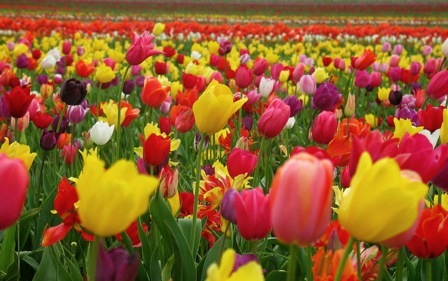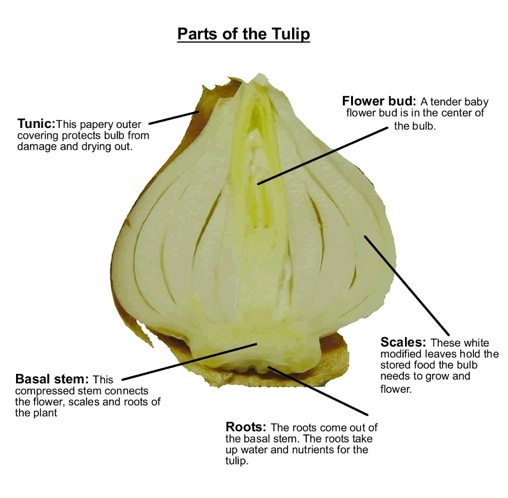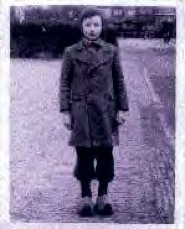
Tulip field in Holland
Tulips: Famine Food, Appetizer Assistant
Many years ago a social acquaintance upon learning I ate weeds said she and her mother had eaten tulip bulbs. If I remember correctly they had dug them up and weren’t going to plant them again so they decided to eat them. She said they boiled them and ate them like onions. She reported the tulips bulbs were good… until they had to go to the hospital.

Tulip Semper Augustus.
That’s one of the problems with tulips. You read they are edible but then you meet someone who ate them and ended up in the hospital. Death from tulip bulb consumption (via a glycoside) is rare but it has happened, particularly in World War II.
A few years after my acquaintance’s comment I was interviewing a businessman who had an import store. At one point he mentioned he was from Holland. Without thinking I asked him quite innocently if he ever ate tulip bulbs. His countenance change and I knew I had crossed some line and the interview as essentially over. He said yes, as a boy, he was forced to eat tulips bulbs to survive War War II. As out of place as my question might have been, he did not mention getting ill.
Let’s see if we can clear up the issue of edibility. This is from the book “The Hunger Winter: Occupied Holland, 1944-1945” by Henrie A. van der Zee, pages 149-150.
“Another ‘delicacy’ the Dutch devoured was tulip bulbs. At the beginning of the war doctors had pronounced the bulbs fit for human consumption, but withdrew this in 1942. In the winter of 1944-45 they were rediscovered, and the Office for Food Supply again published some booklets to tell the Dutch how to handle the bulbs. ‘They contain a lot of starch’

Remove the yellow core before cooking
they told us, ‘and when cooked their consistency will be slightly mealy.’ It was impossible to say how many bulbs were needed for the recipes that followed, but we were advised to peel them, cut them in half and remove the bitter little yellow core. Almost everybody tried it out and nobody liked them, but the Dutch saying ‘Hunger sweetens even raw beans’ was now more true than ever, and Dr. Mees discovered that the bulbs were ‘not too bad’ when boiled like potatoes… Rather better was tulip soup, the authorities had advised. ‘Take one litre of water, 1 onion, 4-6 tulip bulbs, some seasoning and salt… one teaspoon of oil and some curry-substitute. Cut up the onion and brown together with the oil and the curry. Add water and seasoning and bring to the boil, while grating the cleaned bulbs into the boiling liquid. Add salt to taste.’ It had virtually no nutritional value, but it filled the stomach. One had to be careful not to eat too many tulip bulbs as they could cause indigestion… Dahlia bulbs were also tried, but they never became as ‘popular’ as the tulip bulbs. One tulip grower later told an English journalist that he alone had sold 2500 tons of bulbs — ‘crocuses for coffee, daffodils and hyacinths for fodder, and tulips for the humans.'”
Here’s another personal account, this time from Father Leo Zonneveld, who was a boy during the occupation and whose father grew tulips.

Father Leo

Father Leo Zonneveld as a boy
“Trading was very important because there was nothing in the stores to buy, only empty shelves. Money had no value. Of course, there was the black market, but you didn’t dare do anything in public. Father would trade a lot in the beginning, especially with the dairy farmers; however, the last year of the war, there was nothing left to trade. That last part of the war was called the “Hunger Winter.” Even though much of Western Europe had been liberated from Nazis control, Holland remained under their firm grip. I remember the hunger. We were forced to eat tulip bulbs and sugar beets because there was no other food. Bread made from tulips is not very good; I can tell you that! The skin of the bulb is removed, pretty much like an onion, and so is the center, because that is poisonous. Then it is dried and baked in the oven. My mother or older sisters would grind the bulbs to a meal-like consistency. Then they would mix the meal with water and salt, shape it like a meatloaf, and bake it. I can still remember the taste of it: like wet sawdust. Sugar beets were usually thrown to the hogs, but that winter we ate them, too. We still shared tulip bulbs and sugar beets with those with hand-drawn carts who continued to go from door to door. I think seeing my mother still give to the hungry at this time, even though we had very little, made me want to be a missionary: To help people, especially in China or the Philippines who were a lot worse off than we were.”

Tulips fields from the air
From these two personal accounts you know two things. Tulip bulbs are a famine food, and they must be prepared correctly, that is the centers must be removed. Fortunately tulip petals are more edible. The petals can be eaten raw or cooked but loose much of their color when cooked. They can have many flavors: Bland, beans, peas, and cucumbers. Pink, peach and white blossoms are the sweetest, red and yellow the most flavorful. While you can use them to garnish salads their more common use is to hold appetizers or dip. If you use the entire blossom cut off the pistil and stamens from the center of the blossom. The ends of the petals can also be bitter so cut them off as well when used individually.
There is one other word of caution. Some people are quite allergic to tulips and they also cause a common dermatitis problem among florists called “tulip fingers.”
Botanically most tulips are varieties of Tulipa gesneriana, named for Conrad von Gessner, 16th century naturalist and father of bibliography. Tulipa is pronounced TOO-lee-pah and means turban. Gesneriana is said jes-ner-ee-AY-nuh. Incidentally not all species of Tulipa need to be cooked. The Bedouins ate T. amblyophylla raw. And tulips also show up in heraldry now and then, most noticeably in the coat of arms of Raphael. There a bay horse holds tulips in its mouth.
Green Deane’s “Itemized” Plant Profile
IDENTIFICATION: A perennial that grown from a bulb. Can be from four to 28 inches high, usually one flower per stem. The flower has three petals and three sepals which are often darker at the base. They are produced in several colors except blue. They have six distinct stamens. Seed capsules have disc-shaped seeds in two rose per chamber. The stem has few leaves. What leaves there are are strap shaped, waxy, and alternate around the stem
TIME OF YEAR: Usually spring.
ENVIRONMENT: Well-drained soil, temperate climates with long, cool springs and early summers.
METHOD OF PREPARATION: Blossoms raw or cooked. Bulbs cooked AFTER removal of outer skin and inner flower bud. Eating too many tulip bulbs can cause indigestion.



Are all tulip’s species edible in the same way ?
What about the leaves?
Not that I know of.
Ethnic Chinese all over the world pickle tulips for cooking soup and steamed pork/beef. Southern Chinese (Fujian, Guangzhou) in South East Asia also use the pickle to fry certain types of pasta.
Does the tulip have any valuable nutrition?
Recipe from the Closet of Sir Kenelm Digby (1669) [available on Project Gutenberg]:-
PEASE OF THE SEEDY BUDS OF TULIPS
In the Spring (about the beginning of May) the flowry-leaves of Tulips do fall away, and there remains within them the end of the stalk, which in time will turn to seed. Take that seedy end (then very tender) and pick from it the little excrescencies about it, and cut it into short pieces, and boil them and dress them as you would do Pease; and they will taste like Pease, and be very savoury.